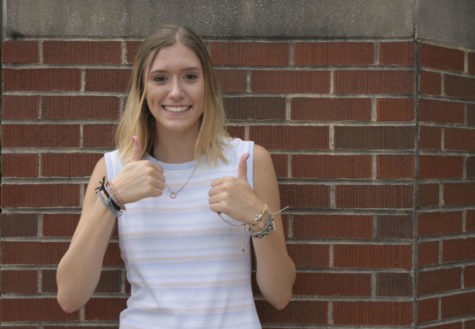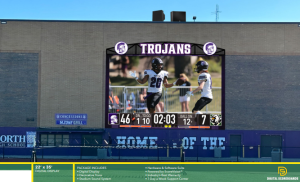BLENDED: Experimental learning debuts with students working in, out of class
May 14, 2019
This school year, two classes officially piloted “blended learning,” typically constructed as semi-independent courses in which students work by themselves online along with the assistance of a teacher on a weekly basis.
One of these classes is a freshman honors English class taught by English department chairperson Christopher Bronke, who wanted to explore the blended concept when considering how to eliminate homework in his classes.
“I really struggled with how to do that. It’s not just as simple as waking up and saying ‘I’m going to stop giving homework,’” Bronke said.
Bronke’s blended class meets in the physical classroom on Mondays and Fridays, and the rest of the week students sign into the cafeteria to work independently or meet with him for one-on-one help.
“If someone were to walk into our class you would see some kids on their Chromebook working, but the majority are collaborating and talking with each other in groups,” freshman Margaret Ward said.
The grading approach differs from that of a traditional class. Instead of receiving grades on each assignment, students receive feedback while they work and have to prove that they have mastered the skill in order to earn a successful grade at the end of a semester.
“I am allowed to have my phone out, listen to music, and talk to my friends. As long as I master my standards by the time of the final, I will succeed in the class,” freshman Gwen Casten said.
The second blended learning course is the early bird consumer education course taught by CTE department chairperson Kimberly Jablonski. Her class meets as a zero hour once a week, and students work independently outside that time.
“A lot of students were taking online coursework for consumer education, but we’d prefer to teach as many of our students as possible,” Jablonski said. “The work days you would typically have in class just get flipped over to your own time.”
Jablonski believes that in the future, blended classes could help free up more time in student schedules and provide more chances for hands-on learning.
“It may provide them opportunities for internships or service learning if their day wasn’t as constrained to be sitting in a classroom at all times,” Jablonski said.
Associate Principal for Staff and Students Kelly Zuerner, who has been working with administration and staff to implement blended learning programs, agrees that these interactive learning experiences can help students excel in the classroom.
“There’s something valuable to be said when you’re out doing a field trip and you’re actually seeing stuff in action,” Zuerner said. “There’s so many endless possibilities.”
Zuerner believes the upcoming renovations included in the Master Facility plan will be able to make some of these ideas possible, and will largely benefit the vision for blended learning in future years.
“It might be that you’re in front of [the teacher] on Monday, Wednesday, and Friday, but on Tuesday and Thursday you’re going to the library or sitting in the commons that we’re eventually going to have,” Zuerner said.
Other local high schools have a head start on the blended track, with many, if not almost all, of their courses available in some type of blended format, compared to the two classes currently offered at DGN.
Huntley High School in Huntley, IL has an almost entirely blended program, with over 60 available courses in nine different subjects.
Ninety-two percent of students surveyed in blended classes at Huntley High School reported that they were satisfied with their blended learning experience.
“They haven’t seen huge gains or losses [in test scores]. What they have seen is students who better understand how they learn and how to own that learning process,” Bronke said.
Naperville Community School District 203 currently offers blended courses in 13 different subject areas.
Despite the increased understanding of students’ own learning, there is still some concern that not all students would be able to handle the personal accountability that blended courses require.
“If we just took a snapshot right now, I would say there probably are some students where the flexible structure isn’t enough for them,” Jablonski said. “I hope we get to a point where it’s something every student can experience. For that to be the case we need to do a better job of building up those skills of time management and self-motivation.”
Bronke thinks that the blended format could actually be utilized as a way to help motivate students who are typically uninterested when it comes to school.
“Even if we don’t know for sure if blended is the answer, it’s at least trying something new. It can’t hurt to try,” Bronke said. “It’s much like a science experiment. If ‘x’ isn’t working, let’s try ‘y’.”
The overwhelming positivity from students at DGN about the current blended speaks for itself.
“I honestly don’t know how I’m ever going to go back to a ‘traditional’ classroom. It forced me to figure out how to manage my time and has taught me how to talk, really talk, with my classmates,” freshman Ava Hamernick said. “I can’t gush enough about this style of learning. It’s great. It’s perfect.”


























